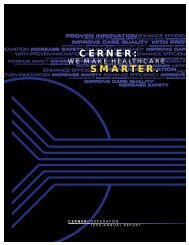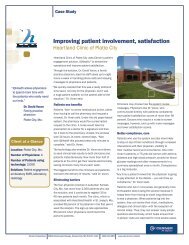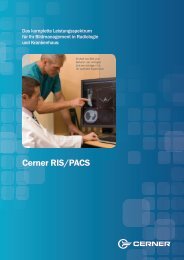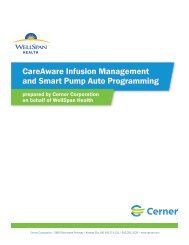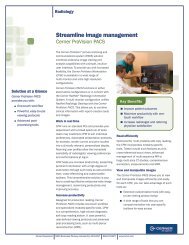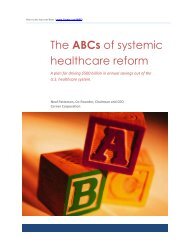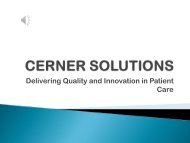The ABCs of systemic healthcare reform - Cerner Corporation
The ABCs of systemic healthcare reform - Cerner Corporation
The ABCs of systemic healthcare reform - Cerner Corporation
- No tags were found...
Create successful ePaper yourself
Turn your PDF publications into a flip-book with our unique Google optimized e-Paper software.
Item 9A. Controls and Procedures<br />
a) Evaluation <strong>of</strong> disclosure controls and procedures. <strong>The</strong> Company’s Chief Executive Officer (CEO) and Chief Financial<br />
Officer (CFO) have evaluated the effectiveness <strong>of</strong> the Company’s disclosure controls and procedures (as defined in the<br />
Exchange Act Rules 13a-15(e) and 15d-15(e)) as <strong>of</strong> the end <strong>of</strong> the period covered by the Annual Report (the<br />
“Evaluation Date”). <strong>The</strong>y have concluded that, as <strong>of</strong> the Evaluation Date, these disclosure controls and procedures<br />
were effective to ensure that material information relating to the Company and its consolidated subsidiaries would be<br />
made known to them by others within those entities and would be disclosed on a timely basis. <strong>The</strong> CEO and CFO have<br />
concluded that the Company’s disclosure controls and procedures are designed, and are effective, to give reasonable<br />
assurance that the information required to be disclosed by the Company in reports that it files under the Exchange Act<br />
is recorded, processed, summarized and reported within the time period specified in the rules and forms <strong>of</strong> the SEC.<br />
<strong>The</strong>y have also concluded that the Company’s disclosure controls and procedures are effective to ensure that<br />
information required to be disclosed in the reports that are filed or submitted under the Exchange Act are<br />
accumulated and communicated to the Company’s management, including the CEO and CFO, to allow timely decisions<br />
regarding required disclosure.<br />
b) <strong>The</strong>re were no changes in the Company’s internal controls over financial reporting during the three months ended<br />
January 3, 2009, that have materially affected, or are reasonably likely to materially affect, its internal controls over<br />
financial reporting.<br />
c) <strong>The</strong> Company’s management, including its Chief Executive Officer and Chief Financial Officer, have concluded that our<br />
disclosure controls and procedures and internal control over financial reporting are designed to provide reasonable<br />
assurance <strong>of</strong> achieving their objectives and are effective at that reasonable assurance level. However, the Company’s<br />
management can provide no assurance that our disclosure controls and procedures or our internal control over<br />
financial reporting can prevent all errors and all fraud under all circumstances. A control system, no matter how well<br />
conceived and operated, can provide only reasonable, not absolute, assurance that the objectives <strong>of</strong> the control<br />
system are met. Further, the design <strong>of</strong> a control system must reflect the fact that there are resource constraints, and<br />
the benefits <strong>of</strong> controls must be considered relative to their costs. Because <strong>of</strong> the inherent limitations in all control<br />
systems, no evaluation <strong>of</strong> controls can provide absolute assurance that all control issues and instances <strong>of</strong> fraud, if<br />
any, within the Company have been or will be detected. <strong>The</strong> design <strong>of</strong> any system <strong>of</strong> controls also is based in part<br />
upon certain assumptions about the likelihood <strong>of</strong> future events, and there can be no assurance that any design will<br />
succeed in achieving its stated goals under all potential future conditions; over time, controls may become inadequate<br />
because <strong>of</strong> changes in conditions, or the degree <strong>of</strong> compliance with policies or procedures may deteriorate. Because<br />
<strong>of</strong> the inherent limitations in a cost-effective control system, misstatements due to error or fraud may occur and not be<br />
detected.<br />
Management’s Report on Internal Control over Financial Reporting<br />
<strong>The</strong> Company’s management is responsible for establishing and maintaining adequate internal control over financial reporting<br />
(as defined in Rule 13a-15(f) under the Securities Exchange Act <strong>of</strong> 1934, as amended). <strong>The</strong> Company’s management assessed<br />
the effectiveness <strong>of</strong> the Company’s internal control over financial reporting as <strong>of</strong> January 3, 2009. In making this assessment,<br />
the Company’s management used the criteria set forth by the Committee <strong>of</strong> Sponsoring Organizations <strong>of</strong> the Treadway<br />
Commission (“COSO”) in its Internal Control-Integrated Framework. <strong>The</strong> Company’s management has concluded that, as <strong>of</strong><br />
January 3, 2009, the Company’s internal control over financial reporting is effective based on these criteria. <strong>The</strong> Company’s<br />
independent registered public accounting firm that audited the consolidated financial statements included in the annual report<br />
has issued an audit report on the effectiveness <strong>of</strong> the Company’s internal control over financial reporting, which is included<br />
herein under “Report <strong>of</strong> Independent Registered Public Accounting Firm”.<br />
Item 9B. Other Information<br />
N/A<br />
50



